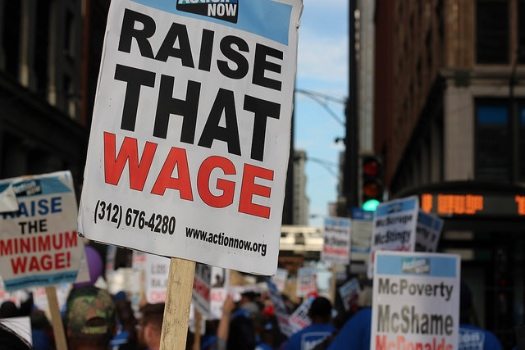
May 25, 2017; Common Dreams and Inside Sources
U.S. Sen. Bernie Sanders (I-VT), with the support of over 20 progressive Democratic senators, has reintroduced a bill to raise the federal minimum wage to $15 an hour by 2024. Lawmakers, economists, and policy groups on both sides of the aisle are now making their cases for and against the Raise the Wage Act. Supporters posit that raising the minimum wage will lift 41 million workers out of poverty without many consequences on the economy and employers. Opponents see the opposite, with employers laying off workers, accelerating or initiating automation initiatives, or closing their doors because of wage increases. Each side builds its data and projections while minimum wage workers rally and demonstrate under the Fight for $15 movement.
The history of the federal minimum wage dates to 1938 when it was first instated at 25¢ per hour. “The federal minimum wage was established in 1938 to help ensure that all work would be fairly rewarded and provide a decent quality of life,” the progressive Economic Policy Institute (EPI) said in a statement when the bill was being introduced. “The current minimum wage falls far short of this goal. Thanks to congressional inaction, the purchasing power of the minimum wage has been eroded by inflation.” The current federal minimum wage of $7.25 has been in place since 2009. Workers who work 40 to 60 hours per week at this wage fall below the federal poverty level and often rely on Medicaid and SNAP (food stamps) to make ends meet.
Taking an opposing position to this issue is the right-leaning (and identically abbreviated) Employment Policies Institute. They cite a 2015 survey of 115 economists who were asked about their reaction to a $15 minimum wage. It finds that 72 percent of U.S.-based economists oppose a $15 federal minimum wage. The survey asks several additional questions that shed light on this topline finding. Five out of six respondents (83 percent) said that a $15 federal minimum wage would have harmful effects on youth employment levels. Three-quarters (76 percent) of respondents said that a $15 minimum wage would have a negative effect on the number of jobs available. And two-thirds (67 percent) of respondents said that a $15 minimum wage would make it more difficult for small businesses to stay in business.
Economic Policy Institute research seems to counter the 2015 Employment Policies Institute survey. Their work in a report issued on April 26, 2017, provides a counterbalance that includes the following summary of who will be impacted:
Snapshot of workers affected by raising the minimum wage to $15 by 2024:
Sign up for our free newsletters
Subscribe to NPQ's newsletters to have our top stories delivered directly to your inbox.
By signing up, you agree to our privacy policy and terms of use, and to receive messages from NPQ and our partners.
- 37.4 million adults
- 26.1 million full-time workers
- 23.1 million women
- 11.6 million parents
- 4.5 million single parents
- 19 million children, whose parents will get a raise
In addition, EPI points out that low-wage workers tend to spend bonuses and raises and would put these additional funds right back into the economy. This would stimulate the economy and cause greater job growth and business activity. According to EPI, raising the minimum to $15 in 2024 would directly or indirectly lift wages for 41.5 million workers, 29.2 percent of the wage-earning workforce.
As 19 states and multiple cities move forward with legislation and ordinances to increase their minimum wages, the federal wage has remained mired in controversy and stagnation. While few of the states and cities increasing the minimum wage have set the bar at $15, all are initiating gradual increases to move the wage scale for low-income workers toward a living wage.
At the introduction of his bill, Sen. Sanders stated, “The erosion of the federal minimum wage is the major reason why 43 million Americans are living in poverty. Healthcare costs are going up, childcare costs are going up, college costs are going up, housing cost are going up, but wages for millions of workers are not going up.”
“So, if you want to know why people all over this country are angry, why they are bitter, why they are disenchanted with their government, the truth is they are asking why it is that the people on top are doing fantastically well and yet their standard of living is going down,” Sanders added.
Readers will remember that in the past, nonprofits in some fields and regions actively resisted or sought waivers for higher minimum or living wage requirements. This created what we call “wage ghettos” within our own sector where workforce scarcity issues endanger our most vulnerable communities. We have suggested that this position is destructive to our selves and our reputations and that nonprofits need to find another way to make business models work.
Members of both parties will hotly debate this bill. Economic reports and surveys will be cited, and lines will be drawn in the sand. But there seems to be little controversy among those who have taken to the streets to march with the Fight for $15 movement. They are clear in their quest to earn a living wage and lift themselves and others out of poverty.—Carole Levine













